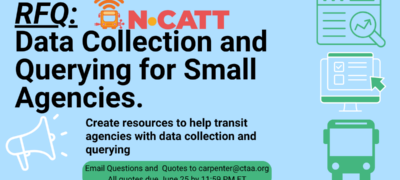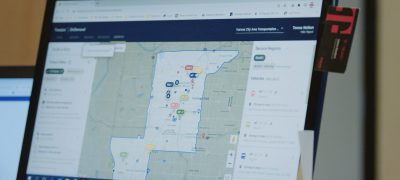In this Technology Procurement Resource, we are focusing on how a community can successfully incorporate micromobility (e.g. bikeshare or scootershare) systems into its transportation network. The City of San Marcos, Texas, and Texas State University partnered to issue a request for proposals (RFP) from bike- and scooter-share companies to deploy a turnkey (i.e. vendor-operated and -managed) service in the City and on the University’s campus.
The City thought to start a micromobility pilot during the part of the pandemic in which seating on buses was limited, but residents still needed to get around. As a result, staff identified bikes and scooters as a strong complement to the bus network to make sure there were enough overall transportation seats in the City. This also feeds into an overall goal of the City Council’s strategic initiative to ensure a well-connected and multi-modal transportation system. Texas State had a bikeshare system in the past whose contract was ending, and wanted to expand micromobility options. In general, the City and University have been working towards a coordinated transit system to increase access to students and residents on- and off-campus. The micromobility pilot seemed like a natural program to fold into this coordinated effort and fulfill major parts of their master plans.
As of this writing, the system has surpassed 150,000 ridden miles, and both the City and University are very pleased with the rollout.
Why it works
What made this work so well rests largely on a very organized, deliberate, and coordinated approach. Both the City and University worked together closely from the beginning with a dedicated team to get the effort off the ground. They made sure to honor each other’s needs and limitations in establishing the program’s parameters; if the City or the University had a restriction such as no riding on the sidewalks, the other made sure to adopt it to maintain consistency across jurisdictions. Both entities emphasized building a highly structured agreement, such as banning micromobility services that don’t have licenses to operate within the City or University. This approach became especially helpful in overcoming any possible hesitancy from both entities’ leadership teams.
By the time they wrote the RFP, they had been piloting the program on the streets. Using the pilot to inform the RFP and the contract proved immensely helpful, as it allowed the team to add insights they would not have thought of without seeing the program in action. This helped to lock in important details that could have otherwise slipped through the cracks, such as being able to access a maintenance account that allows the planners to test service boundaries, speed limits, and other parameters for the scooters, and also setting up a mechanism to enable “priority zones” where the vendor must respond to needs within one hour at any time of day. Knowing what they needed from the program proved invaluable in enabling them to lock their requirements into the RFP.
Their experience during the pilot phase also helped them realize that the key personnel, especially the operations manager, from the vendor need to be employed directly by the vendor, as opposed to a freelance worker. The rollout of the program requires a significant amount of staff time and engagement publicly and among contracting entities. Part of the RFP outlines a schedule of employees based on the number of devices in service. For example, X number of scooters requires 1 operations manager and a certain number of other employees. Double the scooters would require another manager and more employees. Penalties for not maintaining appropriate staffing levels lead to devices being removed from service, therefore impacting profitability, instead of directly calling for fines. Having this requirement in the RFP helped ensure the vendor would be able to meet the community’s operational needs.
This setup ensured that the vendor’s key employees were directly engaged in the work and more reliable than they may have been in other arrangements, and also allowed them to write into the contract how much staff time and participation they would require from the vendor. This type of program requires a dedicated team on the public side and also an engaged provider.
They feel that they were able to mold the program to ensure they found that engaged vendor. Only allowing one vendor to operate led to competition among bidders to offer significant staff time and other agreements that they would not have offered without tight controls in the RFP, and if the program had been opened to a wider pool of operators. This led to selecting a vendor that put the effort in to work with the team on launch events, and spent hours walking around the city and campus with staff to identify boundaries and other parameters for the scooter system.
Learning for the Future
Even with successful procurements, there are still some lessons learned that agencies can incorporate in their next round.
The team recommends that others interested in this approach are very clear about their reporting needs at all levels of government. If there are specific metrics that you are interested in, make sure to call them out in the RFP so you can guarantee you have them. If using a third party to collect and/or manage data, ensure that you have free access to the dashboard for the entirety of the contract; some of these third party managers have “introductory” free rates for a year and then can charge to continue accessing that data.
If coordinating between two entities, like the City and University, make sure there is a clear agreement on what happens with any revenues associated with the program. In San Marcos, the vendor shares a portion of their revenue with the City and University, and it was important for them to clearly outline what funds the income contributes to, who gets to use the funds, and what the money can be used for. Doing so ahead of time can avoid conflict or confusion later.
One thing that both entities said they might do differently for the procurement is to give more of an opportunity for bidders to explain how they will meet specific requirements in the RFP. In addition, they encourage having bidders provide as detailed of a staffing schedule as possible, especially regarding how the company intends to manage turnover among operations staff.
As a final takeaway, it’s especially important for readers to understand that “when we say ‘provide turnkey operation’, that does not mean that it is hands-off or doesn’t take up considerable time for staff management.” That can be a challenge for smaller communities with tight staffing levels. Getting the process right requires a lot of upfront work, and a regular investment in staff time throughout the program, even if the vendor is running the operations. That said, when communities are able to spend the time to be deliberate and structured, it can lead to a highly successful rollout of a new mobility option.
As a reminder, we share these resources for you to learn strategies about how peer agencies have found success. Instead of copying over, we encourage you to read through the document with this writeup in mind to learn what worked for these agencies, and how those takeaways might apply to your work.


